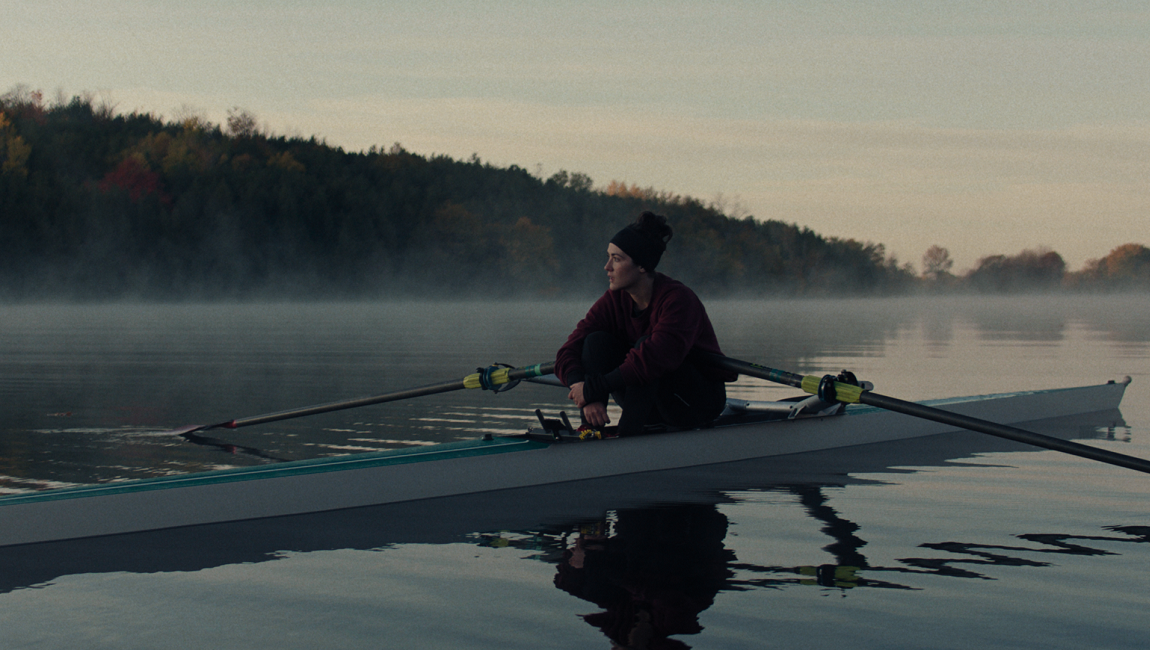Long whispered about by in-the-know cinephiles but seldom seen in American theaters, Greek director Antoinetta Angelidi’s long overdue U.S. debut comes courtesy of Prismatic Ground recognizing her with its Ground Glass award and organizing a complete retrospective of her body of cinematic work. It’s a blind spot that was well overdue to be corrected, with Angelidi possessing the kind of filmography that ought to be a fetish object for those who love the combination of a small, well-organized output with an exceptional batting average in the vein of filmmakers like Robert Bresson and Peter Kubelka: four features and a short, all distinctly the result of a singular voice but with a clear sense of stylistic advancement with each title.
Angelidi has made exactly one feature per decade from the 1970s to the 2000s, none of which passed the 90-minute mark in terms of running time. She began working in black-and-white, but switched to color for her last three features. Her sole monochrome feature was Idees Fixes/Dies Irae, or Variations on the Same Theme (1977). Intended to resemble a musical score and with a palindromic structure, it resembles a series of dioramas and is frequently every bit as static. There are three Warholian long takes (including the first two shots) where the camera remains totally still, and there is virtually no action within the perfectly composed frames, although individuals moving slowly into the background are the slight variations in the drone. One sequence involving a bald woman who kills and plucks a chicken concludes with a reminder of those early shots by turning the illusion of depth into a joke on the audience. It’s among the first tricks from a director who’d later render the same formalist games more insidious. An extended section devoted to playing with language is almost certainly more comprehensible to French and Greek speakers, but the pounding rhythms of its focus on the Greek letter “A” (which serves as something like an “un-” prefix in Greek) calls back to Hollis Frampton’s Zorns Lemma finale. The vocal polyphony would also be developed in the later titles — this is its least polished incarnation.
Topos (1985) is her best-known title in the U.S. thanks to a brief window to see it online for free during the Covid lockdowns, and one can also watch it on Angelidi’s Vimeo (albeit in low quality and with a watermark). One of the rare films to seriously reckon with how to build upon the stylistic gauntlet thrown by Sergei Parajanov’s The Color of Pomegranates and operating in a similar spirit to Peter Greenaway’s work from circa the same time, it claims to be a representation of how women are depicted in Western Renaissance-era art. The women, fittingly, are treated as set design for men to transparently project their feelings onto: a pair of identical female twins are used as a joke on so-called interchangeability. Largely taking place in a black void of space with texture coming from bright splashes of colored fabrics and props, it is practically impossible to summarize what occurs during its tableaux vivants due to its commitment to semiotics, symbolism, and cinematic form itself. The joy of its making is what comes through most potently to dash on the rocks any claims of pretentiousness. Angelidi’s own gamesmanship is typified by what appears to be a conversation between two women with vocal music playing over it, only for the camera to casually reveal that there was a musician singing in a nearby location all along. The musical qualities carry through the rest of the film’s dubbed sound design of variations on mouth noises, resembling a mix of David Lynch and a prototype for the similarly ritualistic qualities of ASMR videos.
Her peculiarly autobiographical The Hours: A Square Film (1995) is the only one of her color projects to regularly step away from the black enclosures that defined the other two, and is perhaps the most inscrutable of the three on first glance. The venturing outside is a necessary choice for a film that takes Angelidi’s inspirations from painting into something vaguely resembling the real world, were it not for the fact that the film’s images and scenes bleed into each other, with real life bumping up against iconography. It results in an experience not dissimilar from how one remembers childhood, particularly the rush of a trip to the museum. Images of pain and trauma are frequently depicted in blurry ellipses, and the line between the self-imposed and the forced becomes equally muddled: initiation in the resistance to the Greek dictatorship is turned into a test-your-mettle cigarette burn, a rape during childhood by her music teacher distorts the music into sound collage, buttocks are used as a Cheshire cat smile. The main character’s relationship to her father and his physical abuse is transfigured via finally, painfully coming to grasp the ability to fully express oneself through art.
The director’s short film, 121280 Ritual, is also an odd title out in terms of its design: shot in 1980 the day before she gave birth to her son, but not finished until 2008 with help from her daughter and frequent collaborator Rea Walldén. (Walldén has recently completed a documentary about her mother, Obsessive Hours at the Topos of Reality, also making its U.S. premiere during Prismatic Ground.) Monochrome and occasionally solarized footage of a pregnant and naked Angelidi making her way around her apartment is tied together via layering heavy breathing, chanting, and a childlike sing-song recital that turns pregnancy into a soundscape piece. It results in a film that looks like Variations but sounds like her later films, a full-circle moment for a director who has always loved structural games.
Angelidi returned to the black enclosure from Topos for her most recently shot work, but Thief or Reality (2001) ranks as one of the most artful navigations of turning a place of nothing into a space of its own. Velvety blacks generally swallow up most of the frame, and the viewer is also sucked into a world where flesh tones are typically the only color. The old Greek architecture is that of the necropolis that is the Underworld, complete with a small cameo from Persephone’s pomegranates. Structured as a triptych with a sculptor of funeral monuments, a grieving mother, and an actor preparing to play Antigone presumably taking the center stage for each section, the titular Thief is the linking point and the excuse to dissolve the boundaries, allowing for one of the most gorgeously intuitive films ever made. One recurring image in Variations featured a razor blade in a mouth, and Thief deliberately remakes it in the form of a kiss: the thorny qualities of human feelings at their rawest intruding into art at its most theoretical and statuesque. Angelidi never stops coming up with pristine compositions and then rendering them messier and thornier, with soundscapes to match. Her images of mourning have a madness to them: a mother-son bath that is simultaneously grief-stricken and inappropriately lewd, a collection of glasses on a table that get used for crystal music before a weirder lunge into the finale to Tarkovsky’s Stalker, and the hopeless joy of her final images shot to date, as two women laugh hysterically at the inevitability of everything falling into their old elemental states as time passes.








